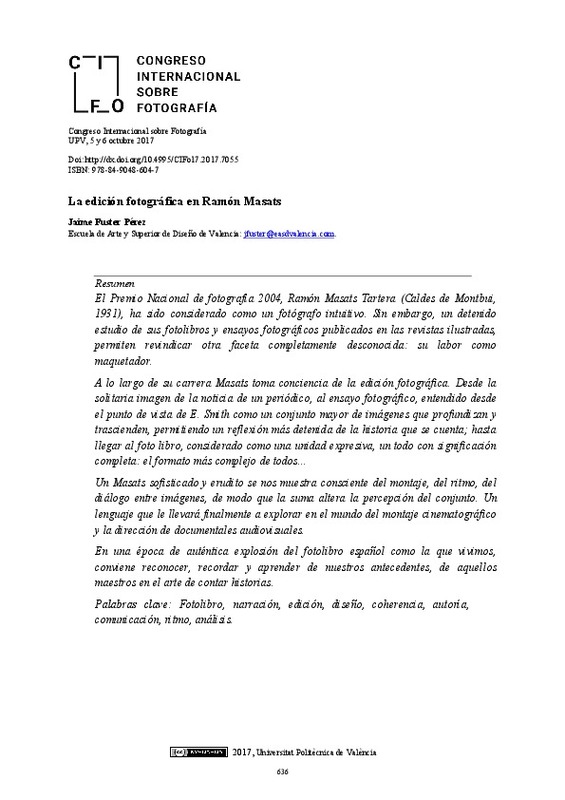|
Resumen:
|
[EN] The National Photography Prize 2004, Ramón Masats Tartera (Caldes de Montbui, 1931), has traditionally been considered an intuitive photographer. However, a careful study of his photographs and photographic essays ...[+]
[EN] The National Photography Prize 2004, Ramón Masats Tartera (Caldes de Montbui, 1931), has traditionally been considered an intuitive photographer. However, a careful study of his photographs and photographic essays published in illustrated magazines unveils another aspect of his craft completely unknown until now: his work as a layout artist. Throughout his career Masats pays great attention to photographic edition: from the lonely image published besides the news in a newspaper, to the photographic essay, understood from E. Smith’s point of view as “a greater set of images that deepen and transcend leading the viewers to a more detailed reflection of the story that is being told; until reaching the photo book, which is considered an expressive unit, a whole with a complete meaning: definitely the most complex format of all. A sophisticated and academic Masats reveals a whole new aspect of his personality, showing his awareness of the layout, the rhythm and the dialogue between images, so that the sum and disposition of the images alter the perception of the whole. A language that will finally lead him to explore the world of filmmaking and the direction of audiovisual documentaries. In an age in which the Spanish photobook is at its peak, it is good to look back and give credit, remember and learn from our background, from those teachers in the art of storytelling.
[-]
[ES] El Premio Nacional de fotografía 2004, Ramón Masats Tartera (Caldes de Montbui, 1931), ha sido considerado como un fotógrafo intuitivo. Sin embargo, un detenido estudio de sus fotolibros y ensayos fotográficos publicados ...[+]
[ES] El Premio Nacional de fotografía 2004, Ramón Masats Tartera (Caldes de Montbui, 1931), ha sido considerado como un fotógrafo intuitivo. Sin embargo, un detenido estudio de sus fotolibros y ensayos fotográficos publicados en las revistas ilustradas, permiten revindicar otra faceta completamente desconocida: su labor como maquetador. A lo largo de su carrera Masats toma conciencia de la edición fotográfica. Desde la solitaria imagen de la noticia de un periódico, al ensayo fotográfico, entendido desde el punto de vista de E. Smith como un conjunto mayor de imágenes que profundizan y trascienden, permitiendo un reflexión más detenida de la historia que se cuenta; hasta llegar al foto libro, considerado como una unidad expresiva, un todo con significación completa: el formato más complejo de todos... Un Masats sofisticado y erudito se nos muestra consciente del montaje, del ritmo, del diálogo entre imágenes, de modo que la suma altera la percepción del conjunto. Un lenguaje que le llevará finalmente a explorar en el mundo del montaje cinematográfico y la dirección de documentales audiovisuales. En una época de auténtica explosión del fotolibro español como la que vivimos, conviene reconocer, recordar y aprender de nuestros antecedentes, de aquellos maestros en el arte de contar historias.
[-]
|








